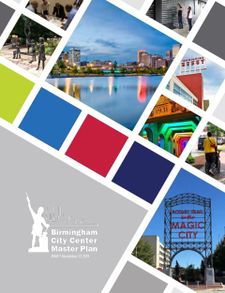2019 City Center Master Plan
The 2019 City Center Master Plan is a City Center Master Plan intended to guide the development of the City Center for the decade beginning with 2019. The plan was drafted by Stantec's Urban Places group, headed by Craig Lewis of Charlotte, North Carolina. It was commissioned by the City of Birmingham in partnership with Regional Planning Commission of Greater Birmingham and REV Birmingham in September 2018 as an update of the previous 2004 City Center Master Plan.
Planner Craig Lewis explained the importance of the city center as "everyone's living room," and stated that its development should reflect, "the highest ideals of the city." Among those ideals are an essential commitment to equity. The plan states that, "[i]nvestments made in the City Center should benefit everyone in the city and people of all backgrounds should be able to live and find opportunities here that facilitate economic mobility."
Process
The City Center Master Plan incorporates earlier Housing Market Analysis and Office and Hotel Market Analysis reports commissioned from Zimmerman/Volk Associates Inc.
Stantec led a series of four meetings with the public, as well as interviews with 120 specific stakeholders, and with focus groups during the development of the City Center Master Plan. A public survey was also conducted through the project website, garnering 1,118 responses.
Guiding Principles
The plan was structured around 6 "Guiding Principles":
- "Equity is essential to Birmingham’s future and Downtown will be its beacon."
- "Focus investments and energy into key nodes to create compact critical mass."
- "Build for people."
- "We are Birmingham: Respect, maintain and celebrate our living history."
- "Jobs drive growth and housing provides vibrancy."
- "Mobility is much more than just moving cars."
Priority Initiatives
The plan laid out 16 "Priority Initiatives":
- "Create a master public realm plan for the Civil Rights District that includes the restoration of Kelly Ingram Park"
- "Renovate/modernize the Birmingham Green/20th Street North."
- "Convert streets back to two-way operations – prioritize 4th, 5th, and 6th Avenues North."
- "Activate empty/underutilized storefronts along 20th Street North, 4th Avenue North (west of 20th Street North), and 2nd Avenue North (east of 20th Street North)."
- "Build 600 units of workforce housing (80% of Average Median Income (AMI) and below) over 10 years."
- "Renovate Brother Bryan Park and install a new streetscape along Magnolia Avenue South."
- "Utilize excess road capacity for mobility that prioritizes, walking, biking (and other slowspeed vehicles), and enhanced transit."
- "Establish a creative placemaking program to spread temporary and permanent art throughout the City Center."
- "Consider an RFP for the redevelopment of Boutwell Auditorium and the City Hall Parking Garage."
- "Install a new streetscape along 16th Street North to connect the Civil Rights District and the Innovation District."
- "Expand the success of Innovation Depot throughout the district to create a vibrant, mixed-use neighborhood."
- "Expand the Business Improvement District services and its boundary."
- "Focus incentives and leadership to encourage new housing and mixed use development in the City Center Core, the Civil Rights District, the Innovation District, and in Five Points South."
- "Complete the Rotary Trail connection to Railroad Park and the Switch Trail in the Innovation District."
- "Eliminate aggressive panhandling."
- "Implement the Character Code to set best practices for new development."
Strategic Opportunity Areas
The plan identified six districts in the City Center, dubbed "Strategic Opportunity Areas" which could benefit from targeted investments. These include the Civil Rights District, Innovation District, City Center Core, Uptown, Five Points South, and Lakeview.
Implementation
The City Center Master Plan included a range of specific "Operations and Management Strategies" which would be helpful in implementing the goals and principles of the plan. These included:
- "Dedicate a person to focus on retail tenant attraction and retention.
- "Prioritize retail/restaurant recruitment along the Birmingham Green (20th Street North) and adjacent blocks."
- "Establish a pop-up retail program."
- "Build 600 units of workforce housing."
- "Light or secure empty spaces."
- "Expand the Business Improvement District services and its boundary."
- "Care for the homeless and eliminate panhandling."
References
- Van der Bijl, Hanno (September 13, 2019) "New Master Plan Coming for Birmingham's Urban Core – What's It Mean for CRE." Birmingham Business Journal
- Van der Bijl, Hanno (December 12, 2019) "Urban planner weighs in on new downtown masterplan." Birmingham Business Journal
External links
- Birmingham City Center Master Plan website
- Stantec (December 2019) Birmingham City Center Master Plan. (22.5 MB PDF)
